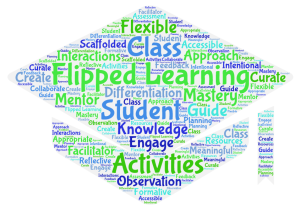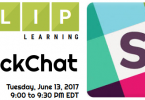--Originally published at Flipped learning – ACEnglishteacher
11 Important Things I Didn't I Know
I’ve been pretty busy lately working on projects and doing courses. Sometimes (especially when I arrive home from a hard day at school, exhausted and still have 25 essays to correct…) I wonder why I do this to myself, but then I do a course like EVO flipped learning 2017 and remember why. Somehow, despite the extra hours and lack of sleep, I feel rejuvenated!
Every year, there’s always something which interests me in the EVO sessions and it’s often hard to choose. The flipped learning sessions have caught my eye before but it wasn’t until this year I opted for them.
Even though, due to other commitments which arose during the course, I couldn’t participate as fully as I would have liked, this course has been a complete game-changer for me.
The terms “flipped classroom” and “flipped learning” have been on my radar for a while now and I’ve always thought it sounded an interesting concept. However, I haven’t known quite enough about it to consider implementing it in class and when I started the course, I soon realised that what I thought I knew wasn’t the whole truth…
What I thought I knew …
I had a very simple vision of flipped learning; basically classwork was done at home (through the medium of video) and homework was done in class and voilá!
What I didn’t know (or hadn’t thought about) …
-
There are 4 “pillars” of flipped learning which provide newbies like me with a helpful checklist
Flexible learning environment
Teachers establish space and time frames depending on situations and individual needs. They physically rearrange their learning spaces as necessary, use observation as a tool for future interactions and provide a variety of ways for students to demonstrate mastery of content.
Learning culture
Flipped learning is a student-centered approach. Direct instruction (usually) takes place outside of the classroom and class time is used to engage students in meaningful activities to practise this new knowledge they bring to class. The role of the teacher in class is not therefore to impart knowledge but to act as facilitator, guide and mentor. Differentiation is evident and activities are scaffolded and accessible to all students.
Intentional Content
Teachers select and prioritize the content to be flipped in order to make best use of class time. Teachers curate and/or create resources, differentiating as appropriate.
Professional educator
Teachers provide ongoing feedback to students and use formative assessment as a tool for future planning. They are reflective and collaborate with colleagues to transform practice.
-
Higher order thinking skills in class
Students focus on the lower order thinking skills (LOTS) of remembering and understanding (Blooms taxonomy) at home. This in theory, means students come to class prepared and armed with the knowledge they need to engage in activities to practise the higher order thinking skills (HOTS) of applying, analysing, evaluating and creating in class time. Class is more learner-centred and interactive and students (working individually, in pairs or groups) get support from the teacher and their peers to complete the more difficult activities requiring HOTS.
-
You can flip just about anything in any subject
As I found out flipping knows no bounds… I can flip absolutely anything! When I first started to consider what I could flip, grammar and vocabulary seemed the most likely candidate. I have since discovered that I can flip listening, reading, writing and speaking just as easily. I am currently reading a great book recommended on the course “Flip It! Strategies for the ESL Classroom” by Robyn Brinks Lockwood which provides lots of practical examples for flipping in the ESL classroom.
-
Direct instruction does not have to be via video
When people talk about flipped learning it often involves students watching a video at home created or curated by the teacher, however, this doesn’t have to be the case. There are many forms direct instruction can take, it may be a reading text, an audio, or preparation for a writing task…
-
You don’t need to create new activities to flip
You can use the resources you already have, be it a textbook, worksheets, videos or audios which come with the textbook. Quite often the activities we don’t have time for in the textbook are the activities which practise higher order thinking skills (HOTS). By focusing on the lower order thinking skills at home, students have more class time for HOTS and thus more opportunities to apply their knowledge and engage with the language on a deeper level. Robyn Brinks recommends checking out the instructor’s manual (teacher’s guide) for ideas and activities you can use when flipping “Often these are directly related to the content, are more interactive, utilize authentic materials, require order-thinking skills, or include ideas for group or pair work, all of which are ideal in a flipped classroom setting. Look for subject headings such as Expansion activities, Extension activities, Optional activities, Reproducible worksheets” (Robyn Brinks Flip It! Strategies for the ESL Classroom)
While I was doing the EVO flipped learning course, I realised that in fact, I was already flipping some elements of my classes without even knowing it. Maybe you are too…
I often get my students to read texts, check vocabulary and (sometimes) complete the comprehension questions at home and then do some kind of speaking activity/pair or group work related to the topic/language structure in class. As I realised while doing the course, students have been focusing on lower order skills (LOTS) at home and we have been practising higher order skills (HOTS) in class; we have been (unconsciously) flipping!
-
You can do an “in-class” flip
For anyone worried about students not doing the “homework” (preparation for class) or for those students who don’t have access to the internet and need it for the direct instruction, you might want to consider an in-class flip. Students are organised into small groups and rotate through work stations. In one station they will have access to the direct instruction and in the other stations they will work on content related to the lesson or other non-related content. Although maybe not a true flip, in the in-class flip model, the teacher still acts as facilitator, guide and mentor as the groups rotate through the work stations and class is still student-centred. For a more detailed explanation check out this article: Modifying the Flipped Classroom: The “In-Class” Version by Jennifer Gonzalez (The Cult of Pedagogy)
-
You can flip face to face and online classes
Loving the idea of flipping but looking to move into online teaching, one of my questions on the course was “Can I flip online classes?” The answer was yes! Just as face to face students receive the direct instruction out of class, so too do online students. Synchronous classes are then used to put into practise the knowledge students bring to class and provide a more interactive experience with the language.
-
You don’t have to flip your heart out in the beginning
It’s okay to take baby steps and feel your way in. Despite my newfound enthusiasm for flipping I’m not ready to flip with all my classes just like that. I’ve decided to choose one class to experiment with and take it from there one step at a time.
-
The benefits for students
Learning is more personalised. Flipped learning makes differentiation easier. As students have access to the instructional content, they can revisit and review as many times as necessary to ensure mastery, working at their own pace in a stress free environment.
If flipped learning works, students should produce a higher standard of work. Having mastered the instructional content at home alone (or with extra support from the teacher) students have more time in class to apply, analyse, evaluate and create in order to assimilate content. Practice makes perfect 
Classes are more dynamic, engaging, collaborative and motivating. Students are active participants of their own learning.
Students can catch up easier when they miss class as they have access to the instructional content.
-
The benefits for teachers
Teachers are free to monitor students, check for understanding, advise and guide. There is more student-teacher time available.
Monitoring in class time provides information for future planning.
Resources created for instructional content can be used again and again.
Students are engaged and (hopefully) enjoying learning.
Engaged students tend to forget to misbehave 
-
An extensive flipped learning network exists
Sounds too good to be true, right? But what about my students who don’t do the preparation? What about those who don’t have access to technology? These were some of my concerns during the course…
In reply, I got the following answers: There are always students who don’t do their homework, be it “traditional” or otherwise. Incorporating some kind of accountability activity (a summary, quiz, entrance ticket etc or adding interactivity to video content with tools such as Playposit, Vizia …) not only engages students with the content but also provides the teacher with information about the learning that has/hasn’t taken place. Issues related to technology can be solved in a variety of ways; as we saw earlier the in class flip is one possibility, providing access to technology in school at breaktimes/lunchtimes is another possibility that was discussed.
The answers to all your questions and are out there… There is a whole community of people who are doing this and doing it successfully! (see useful links below) Despite my initial concerns, I have been truly inspired by these people to give it a go….
My first attempts at flipping …
-
Flipped class 1
One of the tasks on the course was to create a flipped lesson or adapt a lesson you had already done to flip it. I decided to flip a grammar lesson that my students often struggle with: the present simple, present continuous and be going to for the future. I used a Powtoon video that I had already created and used as a revision tool. In a traditional class setting, I would have watched the video and completed the worksheet in class and students would have completed the exercises in the textbook for homework. In the flipped version, they watch the video and complete the worksheet at home and complete the exercises in class in pairs or small groups, followed by extension activties to apply their knowledge. I am sure it is far from perfect (and I won’t be using it until next week so can’t say whether it was successful or not) and I imagine once I am an experienced flipper I will look back at it and think hmmm… however, we all have to begin somewhere. So here it is, my first attempt at flipping a class…
-
(Kind of) flipped class 2
I was doing the course when I realised that it was Safer Internet Day. I cobbled together a class at the last minute, which was kind of flipped, using a tool Vizia (which I found out about on the course) to make video more interactive. Again, far from perfect, but a start…
Students watched the video and answered the questions and poll questions, I collated the information (how many people knew their privacy settings, what they considered an inappropriate photo…) then we discussed their answers in class, first in small groups and then as a whole class.
Do’s and Don’ts when using social media
The seeds have been sown, I’ve dipped in a toe and I’m looking forward to becoming a pro flipper…
Thanks to the excellent moderators and fellow participants on the EVO Flipped Learning course 2017.
If like me, you’re new to flipping, you can find lots of useful information at the following sites (in addition to FlippedLearning.org).
- Flipped learning toolkit
- Daniel V Spencer
- Flipped Learning Global Initiative
- Martha Ramirez English Language Teaching (One of my excellent moderators on the course)
- Flipped Learning simplified with Jon Bergmann (One of the pioneers of the flipped class movement)
- www.theflippedclassroom (in Spanish)
Anyone who is a more experienced flipper, I would love to hear your stories…





Hi,
this is an article I wrote for elearningindustry.com: “How flipped learning has revitalized my career”. You can find it at this link: https://elearningindustry.com/flipped-learning-revitalized-career
Thanks for sharing that article Tiziana! I hope you consider joining many other flipped educators in our Slack Channel: https://flippedlearning.org/fln-updates/join-the-flipped-learning-slack-community/!
This is great! I think we often underestimate how important it is for learners to be able to revisit content when they need it most. In our office, we use Lessonly to give our sales and support teams quick access to important work knowledge when they need it most. Cheers to the future of flipped learning!